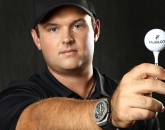 It was in 1893 when the fourteen-year-old Willie finally got his chance. At the unique sixteenth hole, named “Gate”, his father casually launched his tee shot over the wall and burn into the heart of the fairway, (a shot few could manage at the time). Willie struck a perfect mashie towards the green of the short par four. His ball came to a stop right in the middle of a plateau on the green, but as a delighted Willie strode forward, his father began to laugh. Too short to see, young Willie had fallen victim to one of the most notorious holes in golf. The “Gate” hole has a green which has a deep ditch running through the middle of it, and Willie was on the wrong side of the ditch – in four putt territory.
It was in 1893 when the fourteen-year-old Willie finally got his chance. At the unique sixteenth hole, named “Gate”, his father casually launched his tee shot over the wall and burn into the heart of the fairway, (a shot few could manage at the time). Willie struck a perfect mashie towards the green of the short par four. His ball came to a stop right in the middle of a plateau on the green, but as a delighted Willie strode forward, his father began to laugh. Too short to see, young Willie had fallen victim to one of the most notorious holes in golf. The “Gate” hole has a green which has a deep ditch running through the middle of it, and Willie was on the wrong side of the ditch – in four putt territory.
As they walked to their balls, Tom ruffled Willie’s unruly mop of hair and told the boy the news he’d been waiting for. He was to be apprenticed to a renowned local club maker in Gullane, the great Alex Aitken. It was then that the young Willie would gladly leave school behind to become a golf professional, and soon afterwards, a professional golfer. It seems that he readily took to club making and in a remarkably short time, had a strong reputation as a precocious club making genius.
In 1895, local golfing legend Willie Park Jr visited the US to play exhibitions and to layout several golf courses. He also provided recommendations for suitable Scottish professionals to work there and it’s likely that Tom Anderson had asked his old friend to “put in a word” for his son. So in March the following year, young William was put in the care of local North Berwick golf pro Tom Warrender and they sailed for New York on the SS Pomeranian. The journey was hellish and disease ripped through the poor souls on board and resulted in almost thirty per cent of the passengers dying of “ship fever”.
The New York Times reported that on March 21, Anderson took up a post as club pro at Misquamicut Golf Club, Watch Hill on Rhode Island, a course where Park had laid out nine holes a year earlier. Over the next year, Anderson, aged only sixteen, laid out another nine, adding course design to his already strong reputation for club making and as a player. Indeed, newspaper’s report stated that famous amateur Horace Hutchinson considered Anderson to be one of the best club-makers in Scotland – stunning praise for one so young.
He returned home at the end of 1896, but in early 1897 was again at sea, this time with another local, Harry Reddie, who became pro at St Andrews Golf Club, New York before succeeding Willie at Misquamicut.











